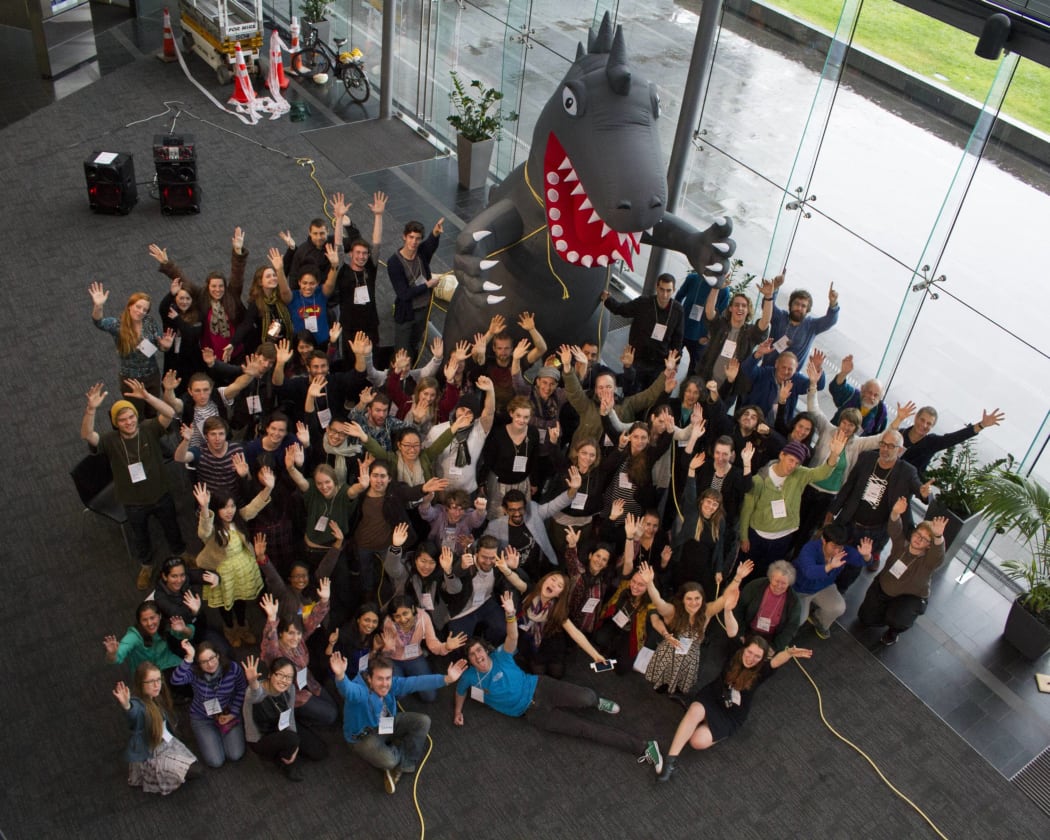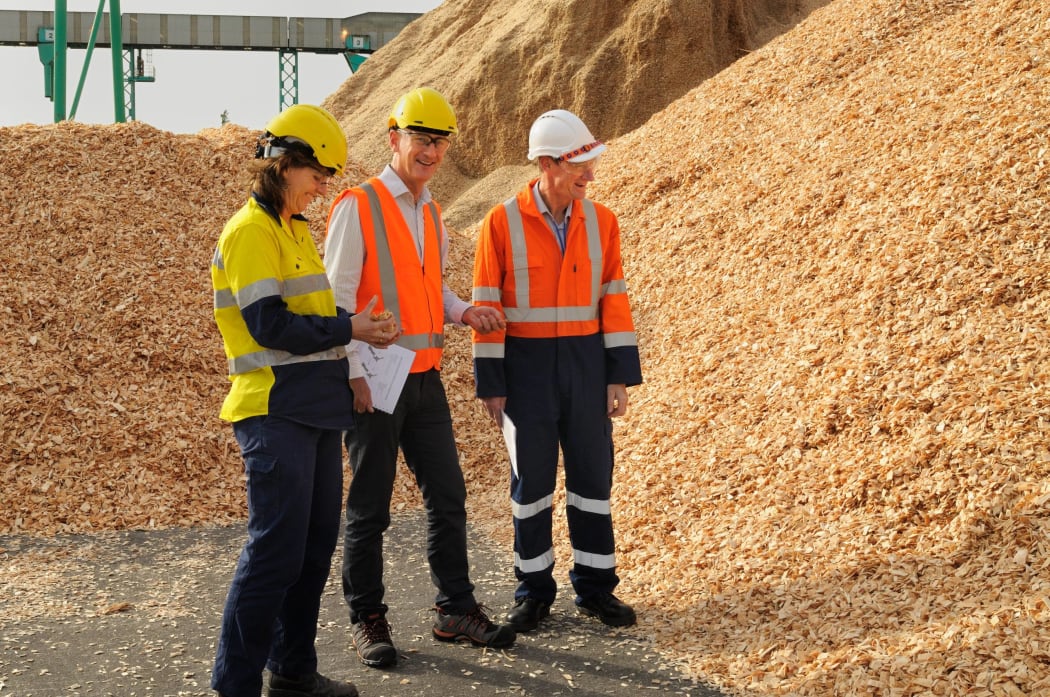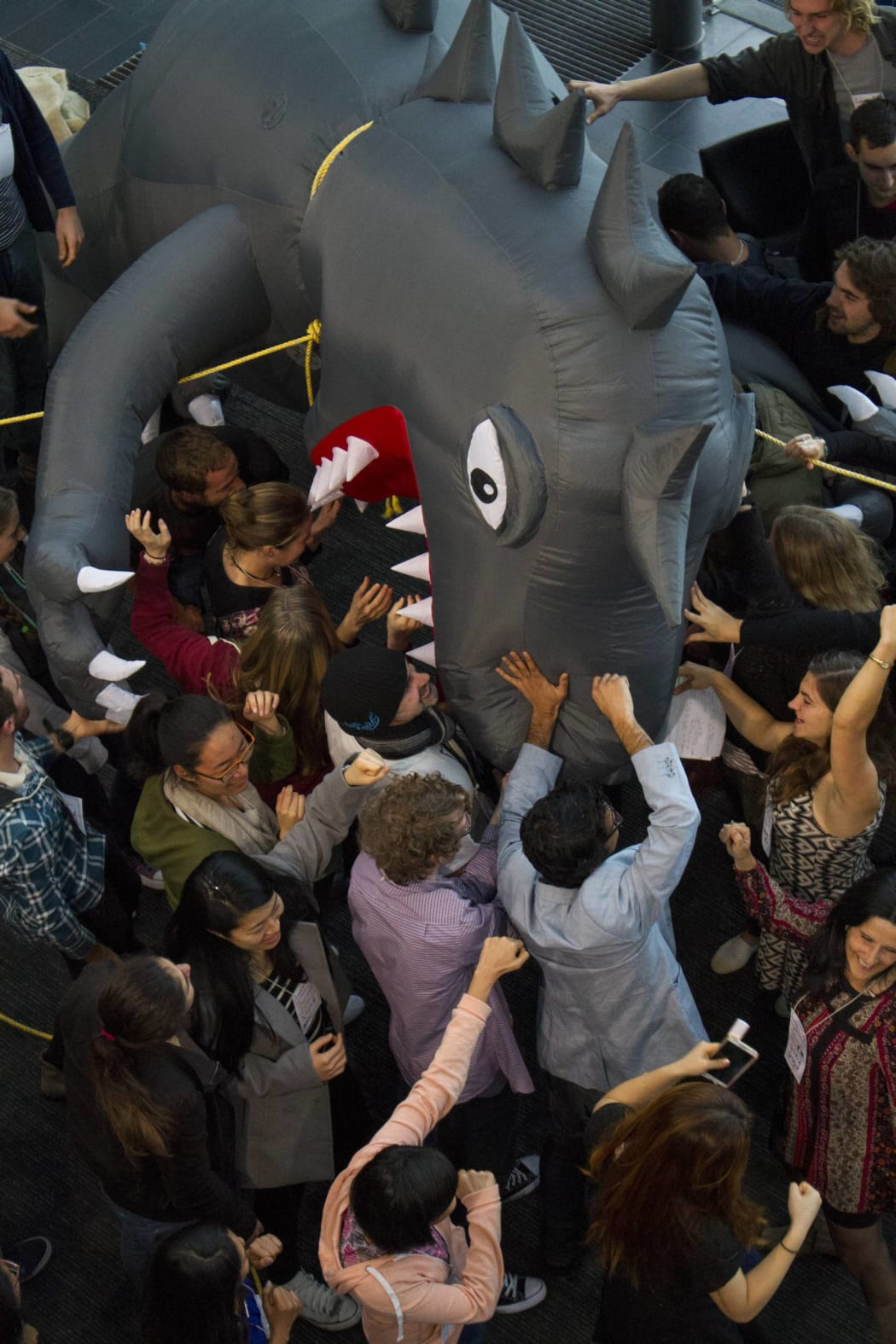Dozens of young people, sprawled in loose circles on the floor of Auckland University’s Business School, are trying to figure out how to make climate change action go viral.
“We need 100,000 people on this Climate Voter thing,” Jimmy Green, a co-organiser of lobby group Generation Zero’s ClimateVote Summit, tells the crowd. “Or as many as we can get!”

Lobby group Generation Zero tries to make climate action go viral. Photo: Levi Brinsdon-Hall II
After two days of talks, workshops and at least one mini-dance mob, the summit’s participants have broken into groups to work on new projects. There’s talk of gigs, flash mobs, market stalls and asking pointed questions at public political meetings.
Several groups are working on promoting Climate Voter, a campaign by six NGOs to encourage people to vote based on climate change policy. Nominate friends to post photos in their swimming gear on Facebook? The jokes roll in. “Get in your swimming gear because your house is going to be underwater...” “You’re a long way from the beach now but you won’t be soon...”
It will need to be exciting and edgy, one participant points out. “It won’t take off unless people want to see it.”
Climate change has often struggled to hold New Zealanders’ attention. In a Roy Morgan phone poll in May, just one per cent of respondents identified climate change as the most important issue facing the country – though six per cent named it the world’s most important issue.
Similarly, Lincoln University’s report Public Perceptions of NZ’s Environment: 2013, climate change (six per cent) lagged behind water-related issues (28 per cent), agriculture-related issues (8 per cent) and waste (seven per cent) as the most important environmental issue facing New Zealand. Yet it rose to 21 per cent, taking the top spot, when respondents were asked to name the biggest environmental issue facing the world.
Sitting in the sunny atrium outside the Generation Zero office in Auckland's St Kevin’s Arcade on the day after the youth summit, co-founder Paul Young says it’s frustrating.
“People think about New Zealand as an isolated part of the world that isn’t influenced by the rest but we’re so interconnected now, in every way really,” he says. “New Zealand can’t be doing well unless the world is doing well.”
In 2013 and 2014, the United Nations’ Intergovernmental Panel on Climate Change (IPCC) published its starkest warnings yet about the risks of global warming.
Across its three-part Fifth Assessment Report, featuring contributions by hundreds of scientists, the IPCC reported [PDF] it was now “extremely likely” that humans have caused the observed warming of the earth’s surface, with each of the last three decades hotter than any previous decade since 1850.
It outlined the key risks [PDF] of a warming world – rising seas, more heat waves, more floods, water shortages, food system breakdowns and threats to some species’ survival.
The IPCC also reported that global greenhouse gas emissions had grown more quickly between 2000 and 2010 than in any of the three previous decades. It estimated a cut of between 40 and 70 per cent by 2050 would be needed to keep the world’s increase in average temperature below the globally-agreed safe upper limit of 2°C.
If nothing is done, it predicted the average temperature could rise by over 4°C by 2100.
READ Pacific island nations are already facing challenges from rising sea levels.
Like the rest of the world, New Zealand’s average temperature and sea levels are expected to rise, with how much depending on whether emissions can be reduced.
There are likely to be a few positives – warmer winters would mean smaller power bills. In some areas, farmers could expect a boost in pasture growth in spring and winter.
But there would also be serious challenges. The country is expected to become wetter in the west and drier in the east, with up to eight per cent more intense rain for every 1°C of warming. Time spent in drought in the east and north is projected to double or triple by 2040.
“So we need to reduce our greenhouse gas emissions. I suppose that concerns me a little bit as a citizen because I don’t see enough action, tangible action, towards reducing those emissions.”
Fire risk would also rise – with an increase in days with ‘very high’ and ‘extreme’ danger in some locations by up to 400 per cent by 2040 and 700 per cent by 2090.
Andrew Tait is a principal scientist at New Zealand’s National Institute for Water and Atmospheric Research (NIWA) and a lead author for the IPCC’s chapter on impact, adaptation and vulnerability for Australia and New Zealand.
The three key risks for New Zealand are floods, wildfires and rising sea levels, he says.
Take the recent flooding in Northland, which devastated local communities. “Those types of events may well be even more intense in future,” he says. “That’s the theory around climate change. If you have a warmer atmosphere, then these storm systems can hold even more moisture. And therefore when they do cross over Northland or Coromandel or Nelson, they can dump even more rainfall in a quick period of time.”
Heavy rainfall and rising sea levels would put coastal communities at increased risk of erosion, saltwater contamination and problems with stormwater drainage.
“All of those things combine to make sea level rise quite a substantial key risk.”
To prevent further change, New Zealand has to be part of international agreements to reduce emissions, Dr Tait says. If not, it will undermine the health of the global accord.
“So we need to reduce our greenhouse gas emissions. I suppose that concerns me a little bit as a citizen because I don’t see enough action, tangible action, towards reducing those emissions.”
READ our election issues primer on the environment.
While New Zealand is on track to meet its emission reduction obligations under the Kyoto Protocol – signed by Helen Clark in 2002 – this is mostly due to credits gained for planting forests.
The country’s emissions in fact rose by 25 per cent between 1990 and 2012. Between 2011 and 2012, the rise was mainly due to rising agriculture emissions followed by energy, including emissions from road transport and electricity production.
Figuring out ways to do more with less – and, crucially, with fewer fossil fuels – will be a major part of reversing this trend.
Chris Mulcare joined New Zealand Trade and Enterprise in 2007 to investigate ways to support the commercialisation of clean technology in New Zealand. Over the next six years, before leaving during a restructuring, he met with many of the country’s pioneers in what turns out to be a surprisingly wide field.
“Clean technology is quite a broad church,” he explains. “It’s products, processes or services that use energy resources more efficiently with a lower environment footprint.”
That includes renewable energy, energy efficiency, biofuels, water and wastewater technology, new materials, new industrial processes and sustainable agriculture.
Mulcare argues New Zealand has failed to create a strategic vision for a shift to a low-carbon, high-tech economy – and that this will prove its biggest mistake in the last ten years.

Chris Mulcare (centre) says the low-hanging fruit for agriculture is to transform our farming model, from chemically-intensive farming to biologically-based farming. Photo: Supplied
“I think deep-down Kiwis like to stand for something,” he says. “I think we have an inter-generational moment here – it was nuclear-free 30 years ago. It’s time to step up and think about our role in the world and how we can be an agent for change.”
There’s a lot of money, smart people and opportunities out there, he says. “With a clearly articulated vision for a clean economy – a smart economy that represents who we are and our values as well as locks down all these opportunities – with that vision, we’ll be a magnet for capital, talent and business opportunities.”
Agriulture produces about half of New Zealand’s greenhouse gas emissions and Mulcare agrees that is one obvious place to start. “The low-hanging fruit for agriculture is to transform our farming model, from chemically-intensive farming to biologically-based farming, and start capturing the value in that protein in supply chains.”
In other words, move away from milk powder (more cows, more paddocks and more emissions) to high-value products that keep more of the supply chain within the country.
The same principle would apply to forestry. Fewer log exports, more logs processed here and turned into “next-generation engineered wood products,” Mulcare says.
“The more you’re processing them onshore, the more residues you produce. The more residues you produce, the more opportunities to turn them into fuels and biochemicals and biomaterials. You’re capturing the value because you’re processing them here.”
*
Agriculture has long been a sticking point for efforts to reduce emissions in New Zealand.
I think deep-down Kiwis like to stand for something,” he says. “I think we have an inter-generational moment here – it was nuclear-free 30 years ago. It’s time to step up and think about our role in the world
In 2003, the government tried to levy farmers to pay for emissions research. Dubbed the “fart tax” (burps are actually more of a problem), it was met by protests organised by Federated Farmers. In what became an enduring image of the protest, National MP Shane Ardern – who also farms in Taranaki – drove a tractor up the steps of Parliament.
Today, a good part of the country’s leading work on agriculture emissions reduction takes place at the government-funded New Zealand Agricultural Greenhouse Gas Research Centre (NZAGRC). The centre collaborates on certain work with the industry-funded Pastoral Greenhouse Gas Research Consortium (set up after the failure of the fart tax).
The NZAGRC’s main focus has been on methane – produced by sheep and cattle during digestion – though research is also taking place into nitrous oxide and soil carbon. It’s looking at breeding low-emitting animals and developing a vaccine and feed compounds.
“The animal breeding is probably the most advanced,” NZAGRC director Harry Clark says. “We’ve got further evidence now that some animals do produce less methane.”
The way it works is simple enough. Sheep and cattle with smaller stomachs process pasture faster, leaving less time for fermentation. “We could have breeding values in the sheep population for selection for methane within the next three years,” Dr Clark says.
“What we’re doing at the moment is dotting the ‘i’s and crossing the ‘t’s to make sure there are no downsides.”
READ about what can be done to balance growing New Zealand’s farming sector with the need to reduce its environmental impact.
Dr Clark – also a lead author for the IPCC on a chapter dealing with land sector emission reduction – says New Zealand has come a long way since the fart tax protests.
“As the climate changes, it influences the amount of food that can be produced. Yes, it is desirable to reduce one of the drivers of climate change, which is greenhouse gas emissions, but you can’t do that at the expense of not producing food,” he says. “I think we’re a lot more sophisticated than we were 10 years ago about thinking about that balance.”
He acknowledges that it will be difficult to reduce overall emissions without tackling the agricultural sector but argues that there is room for optimism. “What we can do is move on a trajectory towards lower emissions intensity in the sector. The sector’s already doing some of that through improvements in productivity.”
Asked about engineering a shift to high-value products, he points out it will be difficult while commodity prices remain high. “When you get milk powder, the price is gold, what’s the point of adding value? You might as well sell milk powder.”
Generation Zero’s Paul Young agrees that achieving enough emission reductions in New Zealand to matter will be complex – and that he and his colleagues may not have the resources to find the best answers. With that in mind and inspired by action in Denmark and the UK, the organisation’s most recent report called on the government to set legally binding targets and regular carbon budgets. It also recommended the establishment of an independent Climate Commission to review targets and research further reduction.

“This is actually our lives. I damn well hope I’ll still be alive in 2060, 2070. Our kids born today should still be alive in 2100,” says Generation Zero's Paul Young Photo: Levi Brinsdon-Hall II
“Our call has always been for a plan,” Young says. “There’s no single policy lever here. There’s a whole array... The most important thing is that we have a government that’s committed to achieving these emission reductions by whatever means.”
In 2012 the Government decided not to sign up to the Kyoto Protocol’s second commitment period, citing a lack of buy-in by other countries. It instead set a similar but voluntary emission reduction target of five per cent below 1990 levels by 2020, with room to increase that to ten to 20 per cent if a global agreement is reached. It has also set a long-term target of a 50 per cent reduction below 1990 levels by 2050.
It was not New Zealand's place to position itself out ahead of where international negotiations were at, Climate Change Minister Tim Groser told the New Zealand Herald in July - and emphasised that only a global agreement could address the problem.
The next major negotiation round for the United Nations Framework Convention on Climate Change will take place in December, ahead of a push to create a universal and legally-binding agreement at the 2015 Climate Change Conference in Paris.
Generation Zero and others will continue pushing for further action at home until then – and beyond. It’s not just a question for the distant future, Young adds.
“This is actually our lives. I damn well hope I’ll still be alive in 2060, 2070. Our kids born today should still be alive in 2100,” he says. “Future generations is maybe not a good way to put it. It’s current generations.”
This content is brought to you with funding assistance from New Zealand On Air.


